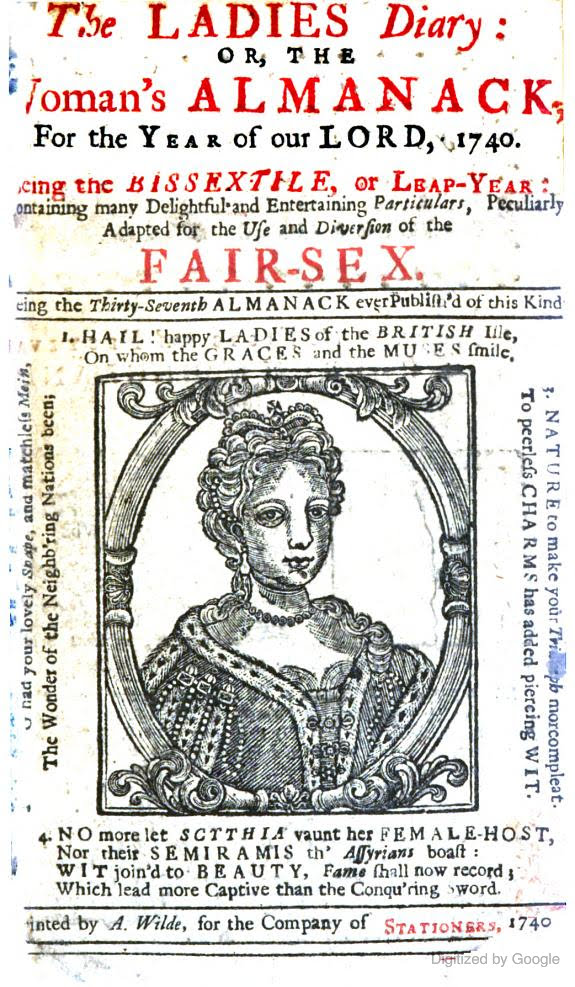- About MAA
- Membership
- MAA Publications
- Periodicals
- Blogs
- MAA Book Series
- MAA Press (an imprint of the AMS)
- MAA Notes
- MAA Reviews
- Mathematical Communication
- Information for Libraries
- Author Resources
- Advertise with MAA
- Meetings
- Competitions
- Programs
- Communities
- MAA Sections
- SIGMAA
- MAA Connect
- Students
- MAA Awards
- Awards Booklets
- Writing Awards
- Teaching Awards
- Service Awards
- Research Awards
- Lecture Awards
- Putnam Competition Individual and Team Winners
- D. E. Shaw Group AMC 8 Awards & Certificates
- Maryam Mirzakhani AMC 10 A Awards & Certificates
- Two Sigma AMC 10 B Awards & Certificates
- Jane Street AMC 12 A Awards & Certificates
- Akamai AMC 12 B Awards & Certificates
- High School Teachers
- News
You are here
'The Ladies Diary': A True Mathematical Treasure
Introduction
Since 2008, Convergence has carried the feature “Mathematical Treasures.” This is a large collection, an archive, of images connected to the history of mathematics: its development, documentation, use, learning, and teaching. It has been assembled with several goals in mind, principally:
- to provide visual materials that can be used in mathematics instruction,
- to call attention to the rich variety of resources about and from the history of mathematics and where they might be obtained and explored further, and
- lastly, to attract researchers whose work could extend the impact and meanings of these objects.
Occasionally, members of the mathematical community have challenged the intent and richness of this collection with such objections as, "Whose treasures are they? I see no value in looking at a mathematical diagram in an old book." Such utterances are unfortunate, and I would advise the speaker to look, and see, more carefully. I believe anyone who loves mathematics can find a personally meaningful piece of mathematical history or heritage among Convergence's collection of hundreds of mathematical treasures. And if not, there are many other sources! Seeking out and recognizing mathematical treasures is an adventure in which anyone can participate, especially in this age of freely accessible digital archives and of greater leeway in personal camera use in libraries, archives, and museums.

Figure 1. Cover of 1740 issue of The Ladies Diary, or Woman's Almanack, featuring a portrait of Caroline, Queen Consort of King George II from 1727 until her death in 1737. From the start, to further attract women readers, its editors displayed on its cover pictures of prominent English women, most often reigning queens, as well as slogans offering genteel and patriotic praise for women. By 1740, editors praised both the "charms" and "wit" of women. (Source: Princeton University Library via Google Books)
A recent treasure that I have discovered will, upon examination, raise little objection to its mathematical value. This is The Ladies Diary, or the Womans Almanack, a periodical published in England from 1704 to 1841. Despite its strange name and, by modern standards, grammatically incorrect spelling and punctuation, this modest 40-page annual was a milestone in the history of modern mathematics education. The Diary’s historical uniqueness and importance is supported by several facts:
- It was one of the first English language publications devoted to women.
- Women readers instigated and focused its content direction toward mathematics and problem solving.
- Through this almanac, women demonstrated both their interest and ability in mathematics at a time and within a culture in which mathematics was a “male activity.”
- Its popularity, surviving in a very competitive market for over 100 years, 1704–1840, is a testimony to its value and sustained interest.
- The Diary was a precursor to the formal scientific journal.
- The Diary became a model to be actively emulated by an extended series of other periodicals promoting mathematical problem solving.
- The evolution of mathematical interests demonstrated over the lifetime of the publication paralleled the mathematical movements taking place in England.
- Mathematically significant personages, both editors and correspondents, were involved in its development.
Frank J. Swetz (Pennsylvania State University), "'The Ladies Diary': A True Mathematical Treasure," Convergence (August 2018), DOI:10.4169/convergence20180827




